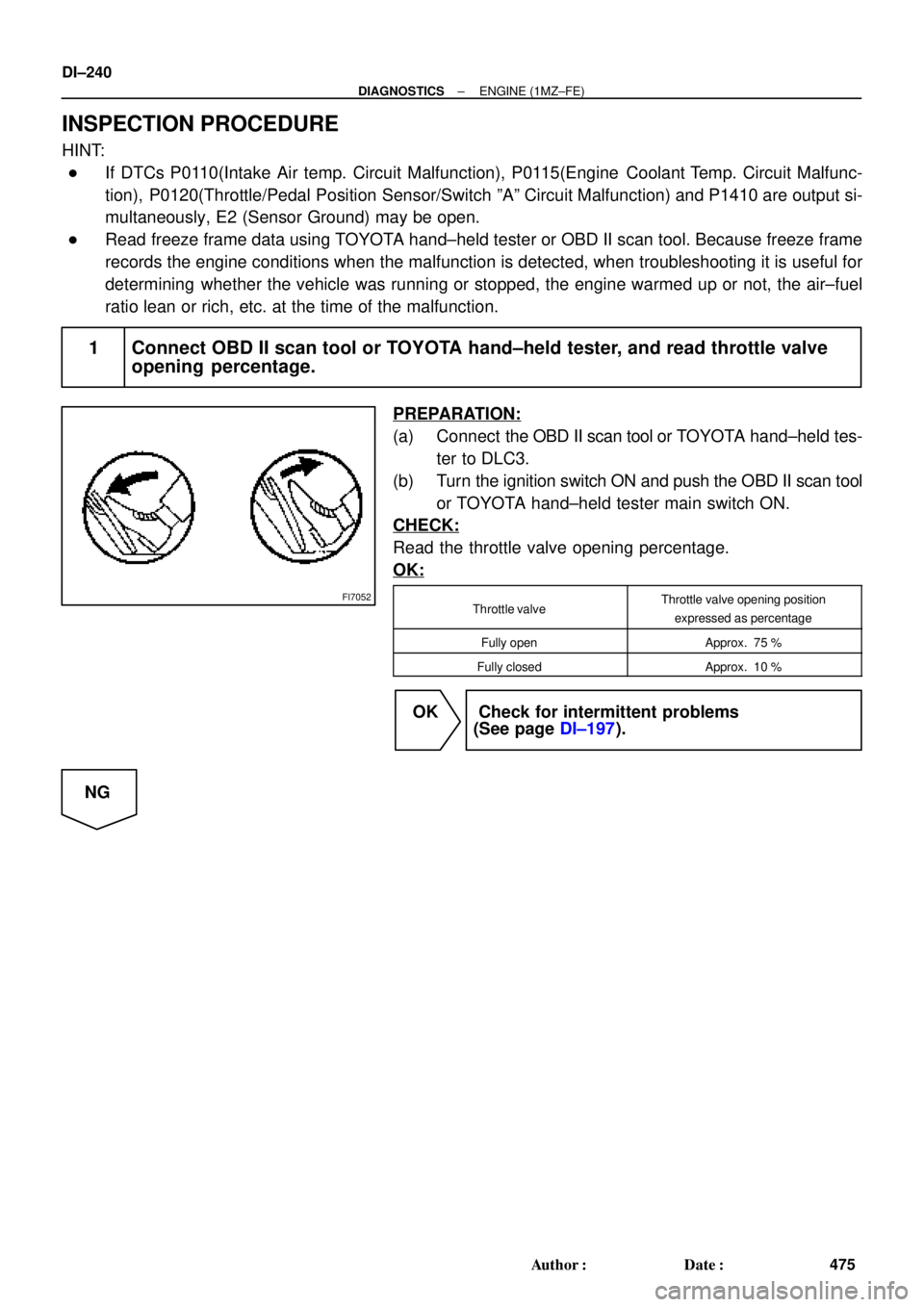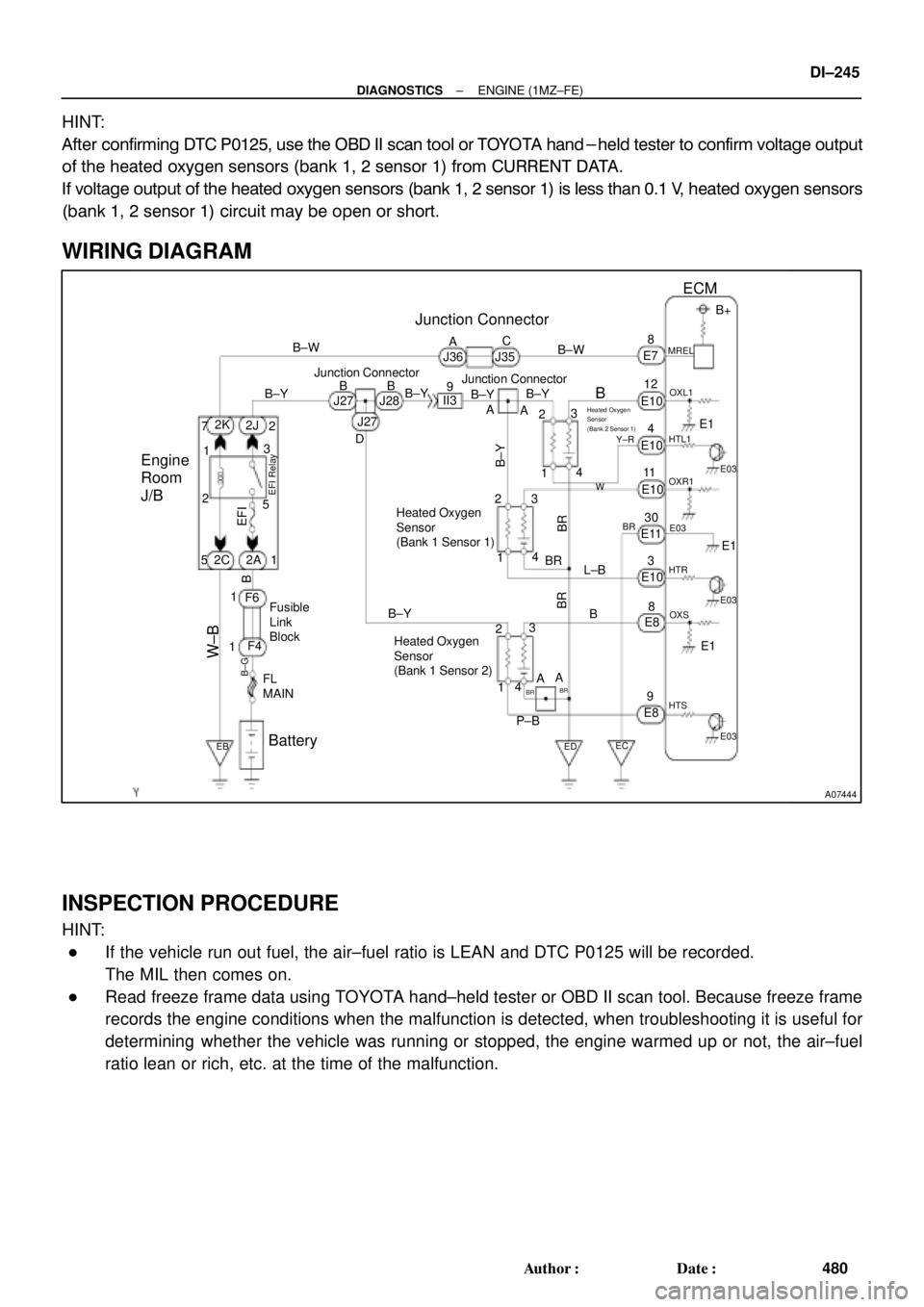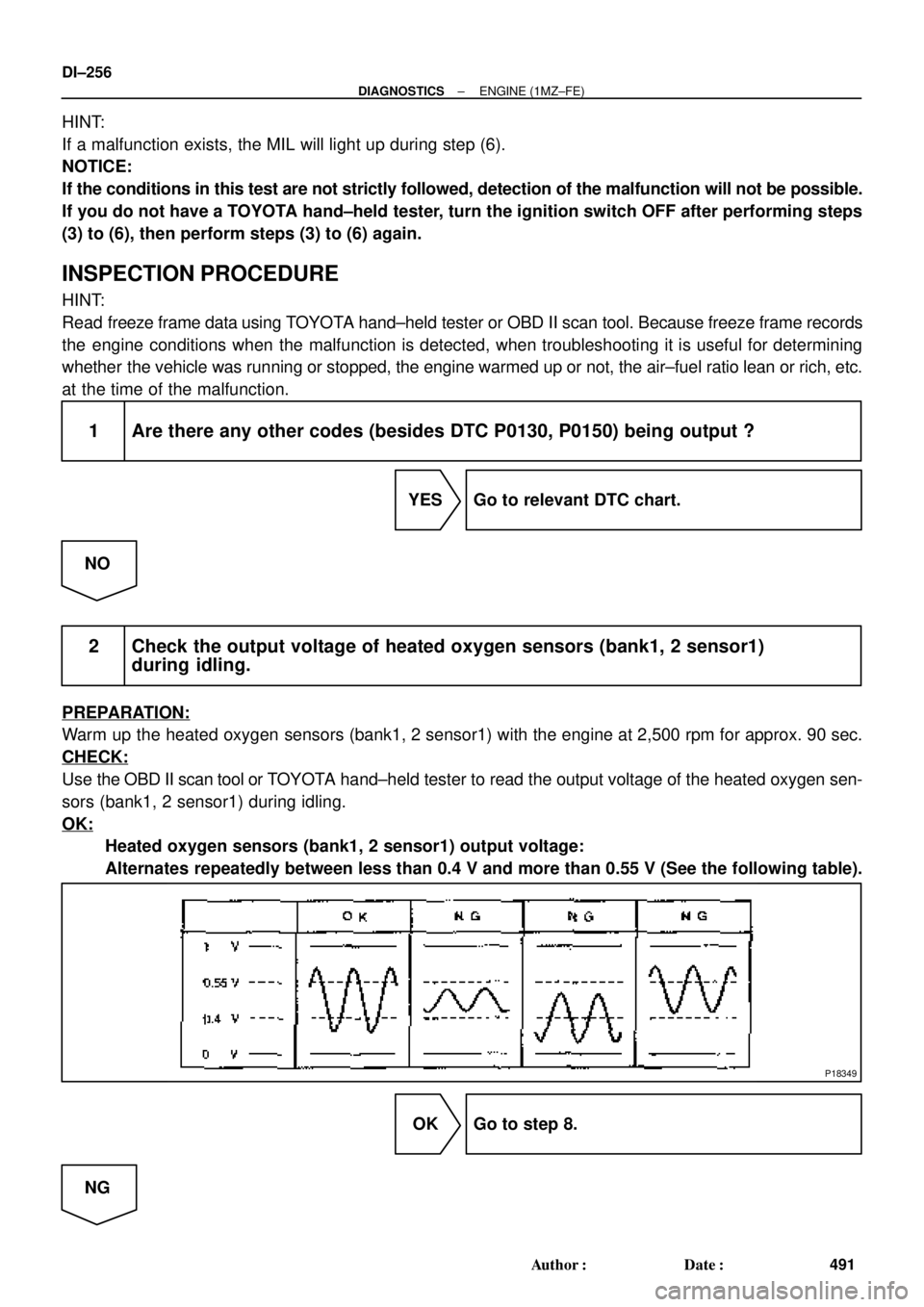Page 2660 of 4770

FI7052
DI±240
± DIAGNOSTICSENGINE (1MZ±FE)
475 Author�: Date�:
INSPECTION PROCEDURE
HINT:
�If DTCs P0110(Intake Air temp. Circuit Malfunction), P0115(Engine Coolant Temp. Circuit Malfunc-
tion), P0120(Throttle/Pedal Position Sensor/Switch ºAº Circuit Malfunction) and P1410 are output si-
multaneously, E2 (Sensor Ground) may be open.
�Read freeze frame data using TOYOTA hand±held tester or OBD II scan tool. Because freeze frame
records the engine conditions when the malfunction is detected, when troubleshooting it is useful for
determining whether the vehicle was running or stopped, the engine warmed up or not, the air±fuel
ratio lean or rich, etc. at the time of the malfunction.
1 Connect OBD II scan tool or TOYOTA hand±held tester, and read throttle valve
opening percentage.
PREPARATION:
(a) Connect the OBD II scan tool or TOYOTA hand±held tes-
ter to DLC3.
(b) Turn the ignition switch ON and push the OBD II scan tool
or TOYOTA hand±held tester main switch ON.
CHECK:
Read the throttle valve opening percentage.
OK:
Throttle valveThrottle valve opening position
expressed as percentage
Fully openApprox. 75 %
Fully closedApprox. 10 %
OK Check for intermittent problems
(See page DI±197).
NG
Page 2663 of 4770

± DIAGNOSTICSENGINE (1MZ±FE)
DI±243
478 Author�: Date�:
DTC P0121 Throttle/Pedal Position Sensor/Switch ºAº
Circuit Range/Performance Problem
CIRCUIT DESCRIPTION
Refer to DTC P0120 (Throttle/Pedal Position Sensor/Switch "A" Circuit Malfunction) on page DI±239.
DTC No.DTC Detecting ConditionTrouble Area
P0121
After vehicle speed has been exceeded 30 km/h (19 mph)
even once, output value of throttle position sensor is out of
applicable range while vehicle speed between 30 km/h (19
mph) and 0 km/h (0 mph)
(2 trip detection logic)
�Throttle position sensor
INSPECTION PROCEDURE
HINT:
Read freeze frame data using TOYOTA hand±held tester or OBD II scan tool. Because freeze frame records
the engine conditions when the malfunction is detected, when troubleshooting it is useful for determining
whether the vehicle was running or stopped, the engine warmed up or not, the air±fuel ratio lean or rich, etc.
at the time of the malfunction.
1 Are there any other codes (besides DTC P0121) being output?
YES Go to relevant DTC chart.
NO
Replace throttle position sensor.
DI07L±06
Page 2665 of 4770

A07444
BatteryJunction Connector
MREL
ECM
B
B+
E1
E03
E03
E1E1
E03 OXL1
HTL1
OXR1
HTR
OXS
HTS
E8E8 E10 E11E7
E10
E10
E108
12
4
11
30
3
8
9
Y±R
3
2
4
1
W
BR
L±B
B
BR
3 2
4
1
B±Y
B±Y
B±Y
A A B Junction Connector
B
J28 J27
J27 B±YJunction Connector
2K
2J
3
1
2
5
EFI
2C 2A 1 5
F6
F4 1
1
B
W±B
EB
FL
MAINFusible
Link
Block
E03
Engine
Room
J/B
B±G
Heated Oxygen
Sensor
(Bank 1 Sensor 2)3
2
1
EDEC
P±BA
A
BR
BR4 B±YHeated Oxygen
Sensor
(Bank 1 Sensor 1)II3 B±WAC
J36 J35B±W
EFI Relay
BR
BR
2 7B±Y9
Heated Oxygen
Sensor
(Bank 2 Sensor 1)
D
± DIAGNOSTICSENGINE (1MZ±FE)
DI±245
480 Author�: Date�:
HINT:
After confirming DTC P0125, use the OBD II scan tool or TOYOTA hand-held tester to confirm voltage output
of the heated oxygen sensors (bank 1, 2 sensor 1) from CURRENT DATA.
If voltage output of the heated oxygen sensors (bank 1, 2 sensor 1) is less than 0.1 V, heated oxygen sensors
(bank 1, 2 sensor 1) circuit may be open or short.
WIRING DIAGRAM
INSPECTION PROCEDURE
HINT:
�If the vehicle run out fuel, the air±fuel ratio is LEAN and DTC P0125 will be recorded.
The MIL then comes on.
�Read freeze frame data using TOYOTA hand±held tester or OBD II scan tool. Because freeze frame
records the engine conditions when the malfunction is detected, when troubleshooting it is useful for
determining whether the vehicle was running or stopped, the engine warmed up or not, the air±fuel
ratio lean or rich, etc. at the time of the malfunction.
Page 2671 of 4770
± DIAGNOSTICSENGINE (1MZ±FE)
DI±251
486 Author�: Date�:
INSPECTION PROCEDURE
HINT:
Read freeze frame data using TOYOTA hand±held tester or OBD II scan tool. Because freeze frame records
the engine conditions when the malfunction is detected, when troubleshooting it is useful for determining
whether the vehicle was running or stopped, the engine warmed up or not, the air±fuel ratio lean or rich, etc.
at the time of the malfunction.
1 Are there any other codes (besides DTC P0125) being output ?
YES Go to relevant DTC chart.
NO
Page 2672 of 4770

DI±252
± DIAGNOSTICSENGINE (1MZ±FE)
487 Author�: Date�:
2 Connect the OBD II scan tool or TOYOTA hand±held tester, and read value for
voltage output of A/F sensors (bank 1, 2 sensor 1).
PREPARATION:
(a) Connect the OBD II scan tool or TOYOTA hand±held tester to the DLC3.
(b) Warm up the A/F sensors (bank 1, 2 sensor 1) with the engine at 2,500 rpm for approx. 90 sec.
CHECK:
Read voltage value of A/F sensors (bank 1, 2 sensor 1) on the screen of OBD II scan tool or TOYOTA hand±
held tester, when you perform all the following conditions.
HINT:
The voltage of AFR�,AFL� terminal of ECM is 3.3 fixed and the AFR�,AFL� terminal is 3.0 V fixed.
Therefore, it is impossible to check the A/F sensor output voltage at the terminals (AFR�,AFL�/
AFR�,AFL�) of ECM.
OK:
ConditionA/F Sensor Voltage value
Engine idlingN t i t 3 3 V (*0 660 V)E i idli�Not remains at 3.3. V (*0.660 V)Engine idlingNot remains at 3.3. V ( 0.660 V)
�Not remains at38V(
*0 76 V) or more
Driving at engine speed 1,500 rpm or more and vehicle
speed 40 km/h (25 mph) or move, and operate throttle valve
open and close
�Not remains at 3.8 V (*0.76 V) or more
�Not remains at 2.8 V (*0.56 V) or less
*: When you use the OBD II scan tool (excluding TOYOTA hand±held tester)
HINT:
�During fuel enrichment, there is a case that the output voltage of A/F sensors (bank 1, 2 sensor 1) is
below 2.8 V (
* 0.56 V), it is normal.
�During fuel cut, there is a case that the output voltage of A/F sensors (bank 1, 2 sensor 1) is above
3.8 V (
* 0.76 V), it is normal.
�
If output voltage of A/F sensors (bank 1, 2 sensor 1) remains at 3.30 V (* 0.660 V) even after performing
all the above conditions, A/F sensors (bank 1, 2 sensor 1) circuit may be open.
�If output voltage of A/F sensor remains at 3.8 V (* 0.76 V) or more, or 2.8 V (* 0.56 V) or less even after
performing all the above conditions, A/F sensors (bank 1, 2 sensor 1) circuit may be short.
*: When you use the OBD II scan tool (excluding TOYOTA hand±held tester).
OK Go to step 10.
NG
3 Check for open and short in harness and connector between ECM and A/F
sensors (bank1, 2 sensor1) (See page IN±31).
NG Repair or replace harness or connector.
OK
Page 2675 of 4770

A01666
Vehicle speed
50 ~ 65 km/h
(31 ~ 40 mph)
(5)Idling
IG SW OFF
1 ~ 3 min. 1 min.Time
(2)
(1)(3)(4)
± DIAGNOSTICSENGINE (1MZ±FE)
DI±255
490 Author�: Date�:
DTC P0130 Heated Oxygen Sensor Circuit Malfunction
(Bank 1 Sensor 1) (Except California Spec.)
DTC P0150 Heated Oxygen Sensor Circuit Malfunction
(Bank 2 Sensor 1) (Except California Spec.)
CIRCUIT DESCRIPTION
Refer to DTC P0125 (Insufficient Coolant Temp. for Closed Loop Fuel Control) on page DI±244.
DTC No.DTC Detecting ConditionTrouble Area
P0130
P0150Voltage output of heated oxygen sensor remains at 0.4 V or
more, or 0.55 V or less, during idling after engine is warmed up
(2 trip detection logic)�Heated oxygen sensor
�Fuel trim malfunction
HINT:
Bank 1 refers to the bank that includes cylinder No.1. Bank 2 refers to the bank that does not include cylinder
No.1. Sensor 1 refers to the sensor closer to the engine body.
The heated oxygen sensor's output voltage and the short-term fuel trim value can be read using the
OBD II scan tool or TOYOTA hand-held tester.
WIRING DIAGRAM
Refer to DTC P0125 (Insufficient Coolant Temp. for Closed Loop Fuel Control) on page DI±244.
CONFIRMATION DRIVING PATTERN
(1) Connect the TOYOTA hand±held tester to the DLC3.
(2) Switch the TOYOTA hand±held tester from normal mode to check mode (See page DI±197).
(3) Start the engine and warm it up with all accessory switches OFF.
(4) Drive the vehicle at 50 ~ 65 km/h (31 ~ 40 mph) for 1 ~ 3 min. to warm up the heated oxygen sensor.
(5) Let the engine idle for 1 min.
(6) Perform steps (3) to (5) three times.
DI07N±07
Page 2676 of 4770

P18349
DI±256
± DIAGNOSTICSENGINE (1MZ±FE)
491 Author�: Date�:
HINT:
If a malfunction exists, the MIL will light up during step (6).
NOTICE:
If the conditions in this test are not strictly followed, detection of the malfunction will not be possible.
If you do not have a TOYOTA hand±held tester, turn the ignition switch OFF after performing steps
(3) to (6), then perform steps (3) to (6) again.
INSPECTION PROCEDURE
HINT:
Read freeze frame data using TOYOTA hand±held tester or OBD II scan tool. Because freeze frame records
the engine conditions when the malfunction is detected, when troubleshooting it is useful for determining
whether the vehicle was running or stopped, the engine warmed up or not, the air±fuel ratio lean or rich, etc.
at the time of the malfunction.
1 Are there any other codes (besides DTC P0130, P0150) being output ?
YES Go to relevant DTC chart.
NO
2 Check the output voltage of heated oxygen sensors (bank1, 2 sensor1)
during idling.
PREPARATION:
Warm up the heated oxygen sensors (bank1, 2 sensor1) with the engine at 2,500 rpm for approx. 90 sec.
CHECK:
Use the OBD II scan tool or TOYOTA hand±held tester to read the output voltage of the heated oxygen sen-
sors (bank1, 2 sensor1) during idling.
OK:
Heated oxygen sensors (bank1, 2 sensor1) output voltage:
Alternates repeatedly between less than 0.4 V and more than 0.55 V (See the following table).
OK Go to step 8.
NG
Page 2679 of 4770

± DIAGNOSTICSENGINE (1MZ±FE)
DI±259
494 Author�: Date�:
DTC P0133 Heated Oxygen Sensor Circuit Slow
Response (Bank 1 Sensor 1) (Ex. CA Spec.)
DTC P0153 Heated Oxygen Sensor Circuit Slow
Response (Bank 2 Sensor 1) (Ex. CA Spec.)
CIRCUIT DESCRIPTION
Refer to DTC P0125 (Insufficient Coolant Temp. for Closed Loop Fuel Control) on page DI±244.
DTC No.DTC Detecting ConditionTrouble Area
P0133
P0153
Response time for heated oxygen sensor's voltage output to
change from rich to lean, or from lean to rich, is 1 sec. or more
during idling after engine is warmed up
(2 trip detection logic)
�Heated oxygen sensor
�Fuel trim malfunction
HINT:
Bank 1 refers to the bank that includes cylinder No.1. Bank 2 refers to the bank that does not include cylinder
No.1. Sensor 1 refers to the sensor closer to the engine body.
INSPECTION PROCEDURE
HINT:
Read freeze frame data using TOYOTA hand±held tester or OBD II scan tool. Because freeze frame records
the engine conditions when the malfunction is detected, when troubleshooting it is useful for determining
whether the vehicle was running or stopped, the engine warmed up or not, the air±fuel ratio lean or rich, etc.
at the time of the malfunction.
1 Are there any other codes (besides DTC P0133, P0153) being output ?
YES Go to relevant DTC chart.
NO
DI4DQ±01